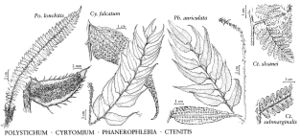Difference between revisions of "Ctenitis sloanei"
Amer. Fern J. 59: 66. 1969.
FNA>Volume Importer |
imported>Volume Importer |
||
| (7 intermediate revisions by 2 users not shown) | |||
| Line 8: | Line 8: | ||
}} | }} | ||
|common_names=Red-hair comb fern;Florida tree fern | |common_names=Red-hair comb fern;Florida tree fern | ||
| − | |basionyms={{Treatment/ID/ | + | |special_status={{Treatment/ID/Special_status |
| + | |code=F | ||
| + | |label=Illustrated | ||
| + | }} | ||
| + | |basionyms={{Treatment/ID/Basionym | ||
|name=Polypodium sloanei | |name=Polypodium sloanei | ||
|authority=Poeppig ex Sprengel | |authority=Poeppig ex Sprengel | ||
| + | |rank=species | ||
| + | |publication_title=Syst. Veg. | ||
| + | |publication_place=4(1): 59. 1827 | ||
}} | }} | ||
|synonyms= | |synonyms= | ||
| Line 20: | Line 27: | ||
}}<!-- | }}<!-- | ||
| − | --><span class="statement" id="st- | + | --><span class="statement" id="st-undefined" data-properties=""><b>Petiole </b>scales orangish, rarely brown, linear or filiform, 20–40 × 0.4–1.5 mm, densely tangled and woollike. <b>Blade</b> 2–4-pinnate-pinnatifid, glabrous or glandular on both surfaces; glands pale yellow, ca. 0.1 mm, appressed. <b>Basal</b> pinnae 22–50 × 10–23 cm, inequilateral, elongate basiscopically. <b>Ultimate</b> segments 2–4 mm wide; margins ciliate. <b>Veins</b> 3–6 pairs per segment, unbranched or 1-forked. <b>Sori</b> medial to inframedial; indusia present but soon deciduous and therefore appearing absent. <b>2n</b> = 82.</span><!-- |
-->{{Treatment/Body | -->{{Treatment/Body | ||
| Line 26: | Line 33: | ||
|elevation=0 m | |elevation=0 m | ||
|distribution=Fla.;s Mexico;West Indies in Antilles;Trinidad;Central America;South America in Colombia;Ecuador;Peru;and Venezuela. | |distribution=Fla.;s Mexico;West Indies in Antilles;Trinidad;Central America;South America in Colombia;Ecuador;Peru;and Venezuela. | ||
| − | |discussion=<p>The names Ctenitis ampla (Humboldt & Bonpland ex Willdenow) Ching and Dryopteris ampla (Humboldt & Bonpland ex Willdenow) Kuntze have been misapplied to this taxon. Ctenitis sloanei and C. submarginalis both have numerous scales at the base of the petiole; in C. sloanei, however, the scales form a large, conspicuous, tangled tuft.</p> | + | |discussion=<p>The names <i>Ctenitis</i> ampla (Humboldt & Bonpland ex Willdenow) Ching and <i>Dryopteris</i> ampla (Humboldt & Bonpland ex Willdenow) Kuntze have been misapplied to this taxon. <i>Ctenitis sloanei</i> and <i>C. submarginalis</i> both have numerous scales at the base of the petiole; in <i>C. sloanei</i>, however, the scales form a large, conspicuous, tangled tuft.</p> |
|tables= | |tables= | ||
|references= | |references= | ||
| Line 35: | Line 42: | ||
-->{{#Taxon: | -->{{#Taxon: | ||
name=Ctenitis sloanei | name=Ctenitis sloanei | ||
| − | |||
|authority=(Poeppig ex Sprengel) C. V. Morton | |authority=(Poeppig ex Sprengel) C. V. Morton | ||
|rank=species | |rank=species | ||
| Line 48: | Line 54: | ||
|publication title=Amer. Fern J. | |publication title=Amer. Fern J. | ||
|publication year=1969 | |publication year=1969 | ||
| − | |special status= | + | |special status=Illustrated |
| − | |source xml=https:// | + | |source xml=https://bitbucket.org/aafc-mbb/fna-data-curation/src/2e0870ddd59836b60bcf96646a41e87ea5a5943a/coarse_grained_fna_xml/V2/V2_605.xml |
|genus=Ctenitis | |genus=Ctenitis | ||
|species=Ctenitis sloanei | |species=Ctenitis sloanei | ||
| − | |||
| − | |||
| − | |||
| − | |||
| − | |||
| − | |||
| − | |||
| − | |||
| − | |||
| − | |||
| − | |||
| − | |||
| − | |||
| − | |||
| − | |||
| − | |||
| − | |||
| − | |||
| − | |||
| − | |||
| − | |||
| − | |||
}}<!-- | }}<!-- | ||
-->[[Category:Treatment]][[Category:Ctenitis]] | -->[[Category:Treatment]][[Category:Ctenitis]] | ||
Latest revision as of 21:24, 5 November 2020
Petiole scales orangish, rarely brown, linear or filiform, 20–40 × 0.4–1.5 mm, densely tangled and woollike. Blade 2–4-pinnate-pinnatifid, glabrous or glandular on both surfaces; glands pale yellow, ca. 0.1 mm, appressed. Basal pinnae 22–50 × 10–23 cm, inequilateral, elongate basiscopically. Ultimate segments 2–4 mm wide; margins ciliate. Veins 3–6 pairs per segment, unbranched or 1-forked. Sori medial to inframedial; indusia present but soon deciduous and therefore appearing absent. 2n = 82.
Habitat: Wooded limestone ledges, hammocks, cypress swamps
Elevation: 0 m
Distribution

Fla., s Mexico, West Indies in Antilles, Trinidad, Central America, South America in Colombia, Ecuador, Peru, and Venezuela.
Discussion
The names Ctenitis ampla (Humboldt & Bonpland ex Willdenow) Ching and Dryopteris ampla (Humboldt & Bonpland ex Willdenow) Kuntze have been misapplied to this taxon. Ctenitis sloanei and C. submarginalis both have numerous scales at the base of the petiole; in C. sloanei, however, the scales form a large, conspicuous, tangled tuft.
Selected References
None.
